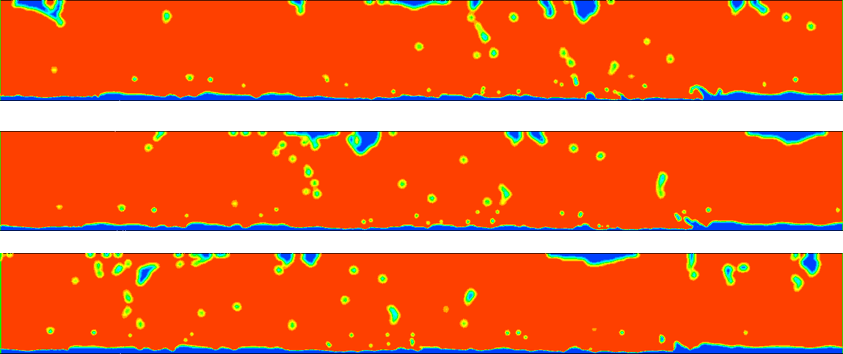Computational Fluid Dynamics (CFD) is a popular method used for modeling systems utilizing single-phase flows and is widely used across industries for design optimization. However, their use in two-phase systems has been limited due to added complications of the two-phase interface with mass transfer causing complex flow behavior not easily predictable. CFD models are very promising in comparison to traditional techniques because they can predict detailed transient variations in individual phase velocities, void fractions and corresponding temperatures, not possible with other techniques. An accurate CFD model can not only address the flow transitions but also the corresponding heat transfer and pressure drop behaviors.
In collaboration with High Performance Computing Cluster in CWRU (HPC), we are able to conduct more intense and complicated CFD simulations in a variety of boiling and condensation systems. Specific focus is on developing more robust and accurate mass transfer models as they seem to have a significant impact on the flow behaviors in two-phase systems. We have successfully developed modeling strategies that can predict the flow behaviors in two-phase systems with good accuracy.
Related Publications
[9] CN Huang, KL Lee, C Tarau, Y Kamotani, C Kharangate, Thermal and Hydrodynamic Analysis of a Self-Purging Hot Reservoir Variable Conductance Heat Pipe, Applied Thermal Engineering, 120346, https://doi.org/10.1016/j.applthermaleng.2023.120346
[8] CN Huang,KL Lee,C Tarau,Y Kamotani,C Kharangate, Computational Fluid Dynamics Model for A Variable Conductance Thermosyphon, https://www.sciencedirect.com/science/article/pii/S2214157X21001234
[7] Y Qiu, H Lee, CR Kharangate, Computational investigation of annular flow condensation in microgravity with two-phase inlet conditions, International Communications in Heat and Mass Transfer 118, 104877. https://doi.org/10.1016/j.icheatmasstransfer.2020.104877
[6] KL Lee, C Tarau, A Lutz, WG Anderson, CN Huang, C Kharangate, Y Kamotani, Advanced Hot Reservoir Variable Conductance Heat Pipes for Planetary Landers. https://ttu-ir.tdl.org/bitstream/handle/2346/86409/ICES-2020-579.pdf?sequence=3
[5] CR Kharangate, I Mudawar, Review of computational studies on boiling and condensation, International Journal of Heat and Mass Transfer 108, 1164-1196. https://doi.org/10.1016/j.ijheatmasstransfer.2016.12.065
[4] CR Kharangate, H Lee, I Park, I Mudawar, Experimental and computational investigation of vertical upflow condensation in a circular tube, International Journal of Heat and Mass Transfer 95, 249-263. https://doi.org/10.1016/j.ijheatmasstransfer.2015.11.010
[3] H Lee, CR Kharangate, N Mascarenhas, I Park, I Mudawar, Experimental and computational investigation of vertical downflow condensation, International Journal of Heat and Mass Transfer 85, 865-879. https://doi.org/10.1016/j.ijheatmasstransfer.2015.02.037
[2] CR Kharangate, H Lee, I Mudawar, Computational modeling of turbulent evaporating falling films, International Journal of Heat and Mass Transfer 81, 52-62. https://doi.org/10.1016/j.ijheatmasstransfer.2014.09.068
[1] CR Kharangate, Experimental, theoretical and computational modeling of flow boiling, flow condensation and evaporating falling films. https://docs.lib.purdue.edu/open_access_dissertations/783/


